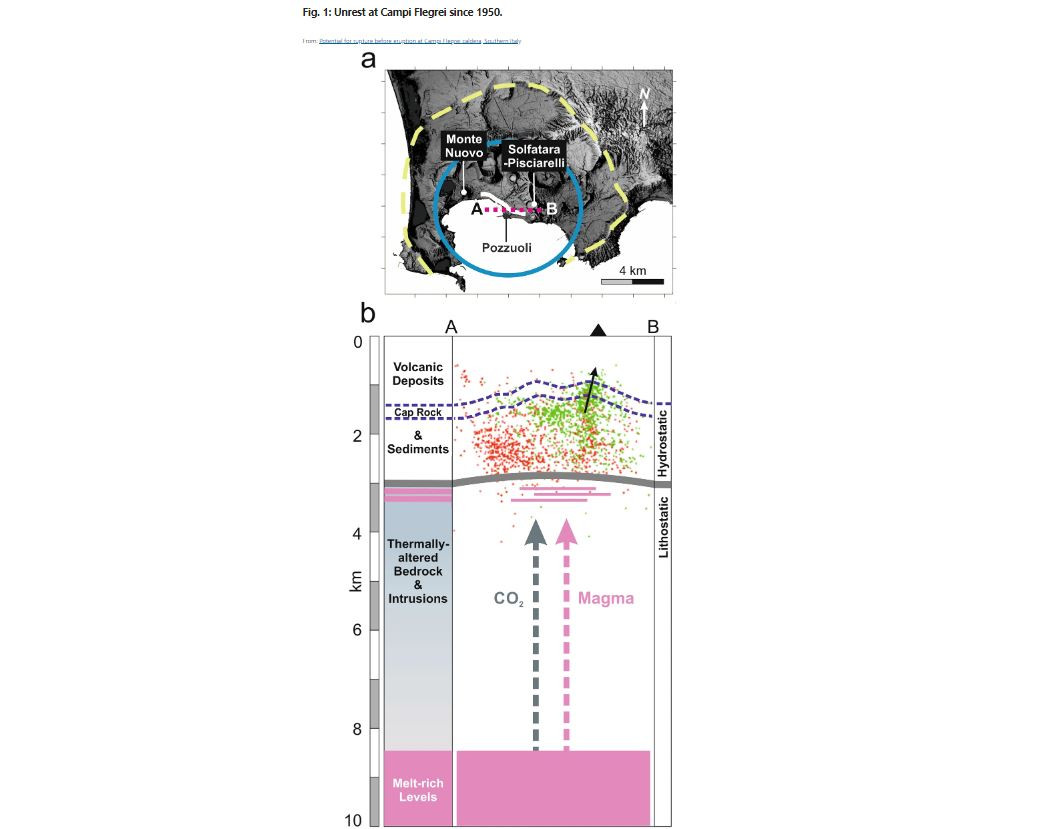Experts are monitoring the phenomenon as a possible eruption could threaten thousands of people – An eruption could be comparable to the one that destroyed Pompeii in AD 79
A “supervolcano” in a densely populated part of Italy may be on the verge of its first eruption since 1538, researchers have warned.
The Campi Flegrei volcano near Naples in southern Italy has become weaker and more prone to rupture, making an eruption more likely, experts say.
It is located about nine miles (14.5 km) west of Naples and is one of the few active supervolcanoes in the world.
About 360,000 people live in Campi Flegrei, and the area may need to be evacuated if experts deem it to be at immediate risk of an eruption, although scientists say there is no absolute certainty that will happen soon.
When the volcano finally erupts, it is likely to be comparable in size to the eruption of Vesuvius that destroyed the cities of Pompeii and Herculaneum in AD 79.
The study was conducted by experts at Italy’s National Research Institute for Geophysics and Volcanology (INGV) and University College London (UCL).
The Campi Flegrei volcano in Italy has become weaker and more prone to rupturing, suggests a new study led by Professor Christopher Kilburn @UCLHC @ES_UCL @uclmaps with @INGV_press interpreting recent patterns of ground uplift and mini local earthquakes https://t.co/CnSIJBIzKN pic.twitter.com/CGJCRIS6eu
— UCL News (@uclnews) June 9, 2023
Lead author Professor Christopher Kilburn at UCL’s Department of Earth Sciences said Campi Flegrei is more prone to ‘rupturing’ – breaking or breaking through the rock that makes up the body of the volcano.
“It’s a natural result when the volcano stretches as pressure builds up underground,” Professor Kilburn told MailOnline.
“Once a rupture occurs, it will be easier for the volcanic fluids to escape.
A rift could open a crack through the Earth’s crust, although the magma still needs to be pushed into the right place for an eruption to occur.
The large, eight-mile-wide caldera of Campi Flegrei—the basin-like depression resulting from a previous eruption—lies beneath the western suburbs of the city of Naples.
About a third of the caldera is partially submerged beneath the Gulf of Pozzuoli, but the remaining two-thirds is land that is home to more than 360,000 people.
Campi Flegrei (or “flaming fields”) is designated a supervolcano because it has the potential to produce a magnitude eight eruption, capable of ejecting more than 200 cubic miles of material.
People live in the area and would be at risk if the volcano erupted again and spewed “pyroclastic flows” – hot and fast-moving streams of gas and solidified lava particles.
Campi Flegrei last erupted when Henry VIII was last on the English throne and this event came after a gap of around 3,000 years.
But researchers warn that large calderas of this kind often go through several decades of unrest before erupting.
Campi Flegrei has been undisturbed since the mid-20th century, which is of particular concern to scientists.
It had several two-year periods of unrest in the 1950s, 1970s and 1980s that caused small, localized earthquakes and ground uplift due to the movement of magma below the surface.
However, Campi Flegrei’s current tensile strength – the maximum pressure a material can withstand before it breaks when stretched – is likely to be about a third of what it was in 1984, the researchers said.
Additionally, over the past decade, the ground beneath Pozzuoli has been creeping up at about four inches a year as gas increases pressure on the magma, causing the ground surface to swell and deform.
The new study used a volcanic fracturing model, developed at UCL, to interpret the patterns of earthquakes and ground uplift, and concluded that parts of the volcano were stretched almost to breaking point.
“This is the first time we’ve applied our model, which is based on the physics of how rocks break, in real time to any volcano,” Professor Kilburn said.
“The first use of the model was in 2017 and since then Campi Flegrei has behaved as we predicted, with an increasing number of small earthquakes showing pressure from below.
“We will now have to adjust our procedures to estimate the likelihood of opening new pathways for magma or gas to reach the surface.”
A potential eruption may be preceded by relatively weak signs, such as less ground uplift and fewer earthquakes.
This was the case with the Rabaul caldera eruption in Papua New Guinea in 1994, which killed five people, largely due to good disaster planning.
The eruption was preceded by small earthquakes that occurred at one-tenth the rate of what had occurred during a crisis a decade earlier.
Professor Kilburn said authorities were well prepared in the event of an emergency, although “there is no reason to believe they are needed now”.
Immediate signs that a volcano is about to erupt include cracks in the ground and dark streams of volcanic gases being emitted. However, Campi Flegrei is not at this stage.
“The volcano is showing signs that the crust is weakening as it continues to stretch,” Professor Kilburn told MailOnline.
With information from DailyMail
Source :Skai
With a wealth of experience honed over 4+ years in journalism, I bring a seasoned voice to the world of news. Currently, I work as a freelance writer and editor, always seeking new opportunities to tell compelling stories in the field of world news.











